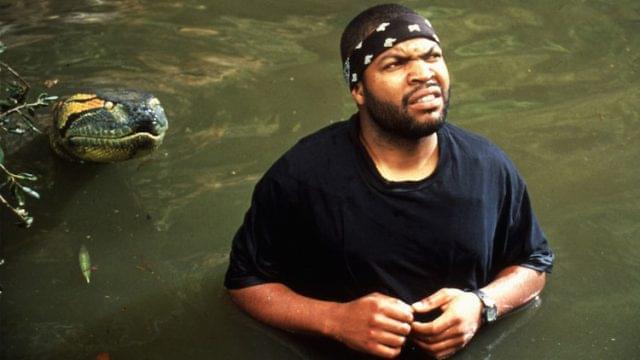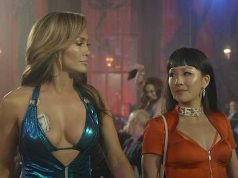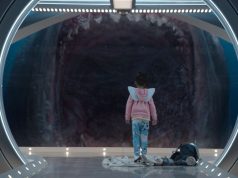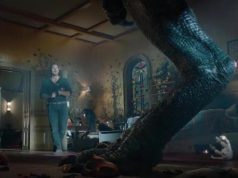
The phrase “so bad it’s good” is a misnomer. What we usually mean by it is that we found a movie’s particular brand of badness entertaining. But just because we’ve gotten enjoyment out of it doesn’t mean it’s “good” — it merely means that we’ve made lemonade out of lemons. “So bad it’s entertaining” would be a more accurate phrase.
“Anaconda” falls under this category. It was intended as a scary, suspenseful horror film about a giant snake that pesters travelers on the Amazon. Its flaw is that it is neither scary nor suspenseful, and also that its giant snake looks suspiciously like second-rate computer animation. That’s what makes it bad. What makes it entertaining is that it fails in hilarious ways. And since laughing is an enjoyable experience, you can see why we’d be tempted to call the movie “so bad it’s good.” But it would only be “good” if it had intended to make us laugh. It has failed to do what it set out to do. That we have found some alternate way of enjoying it is merely a testament to our good old American optimism.
I bring this up because while “Anaconda” is unquestionably bad, I do not dislike it. I first saw it in a theater in 1997 with a few friends, and we laughed all the way through it, well aware that laughter was not the film’s intended response. In fact, the other people in the audience (there were not very many) seemed to be as scared as the movie wanted them to be. It is not my custom to review audiences, but if I were reviewing this audience, I would give it a C+ for being easily scared.
“Anaconda” begins with a text scroll basically saying that there’s a snake called the anaconda, and that it’s really big. You know, in case you hadn’t heard of it. This text also mentions a crucial bit of information: “They will regurgitate their prey in order to kill and eat again.” (This is also true of Ann Coulter.) If you’re on top of things, you think, “Hmm, I bet that’s gonna happen at some point in the movie!” If you’re on top of things in the sense of having seen the film before, you think, “I bet the snake is going to eat Jon Voight and then barf him up, whereupon Jon Voight — still half-alive and half-digested — will wink at Jennifer Lopez.”
After the text scroll, the movie begins for real with a terrified man on a boat being pursued by something we can’t see. Many of the shots are from the point of view of the pursuer, very low to the ground, so it looks like the man is being chased by a dwarf with a movie camera. He (the terrified man, not the midget filmmaker) climbs up the ship’s mast and shoots himself in the head. His message is clear: He would rather die than continue to be in this movie.
After all that, THAT’S when the movie begins for-real for real. A filmmaker named Terri Flores (Jennifer Lopez) is on the Amazon to make a documentary about an isolated native tribe. Terri is of normal height, so she evidently was not the miniature filmmaker chasing the scared guy in the first scene. You know, the more I think about it, the more I think it was supposed to be an anaconda that was chasing him. Huh.
Anyway, Terri’s boyfriend, Cale (Eric Stoltz), is the producer, with Danny (Ice Cube) as the cameraman. They’ve brought along a stuffy British guy named Westridge (Jonathan Hyde) to be the film’s host and narrator, and also because a movie like “Anaconda” needs a foppish, wormy guy to be hilariously eaten by whatever the movie’s terror is. (See also: the lawyer-on-the-toilet in “Jurassic Park.”) We learn who the other two crew members are because they announce themselves. One of them, Denise (Kari Wuhrer), tells someone, “I’m the production manager!” So apparently she’s the production manager. Then she refers to the other one, Gary (Owen Wilson), as “sound guy.” So he must be the sound guy. According to the film’s credits, it took three people to write this dialogue.
With a Brazilian named Mateo (Vincent Castellanos) piloting their boat, the film crew is heading down, or possibly up, the Amazon when they encounter a man with a malfunctioning boat of his own. They bring him aboard like good Samaritans, or like whatever the South American equivalent of a good Samaritan is. The man’s name is Paul Sarone, and he is played by Jon Voight channeling Christopher Walken channeling Zorro.
Sarone, an oily, leering, ponytailed Paraguayan, says he was a priest before becoming a snake hunter, and he says he knows where the hidden tribe is. He promises to lead the filmmakers to them. He also says things like “This river can kill you a thousand ways,” which is kind of poetic. Even better is his monologue that goes like this:
“Anacondas are a perfect killing machine…. They strike, wrap around you, hold you tighter than your true love, and you get the privilege of hearing your bones break before the powerful embrace causes your veins to essplode.”
So Sarone obviously has a weird fetish for anacondas, as do the tribespeople they’re looking for, who reportedly worship the snakes, which would be kind of like Californians worshipping earthquakes. But I don’t want to get into a religious debate here.
Cale, the producer, has to get in the water to fix the boat’s propeller — I don’t know why this is his job rather than the pilot’s — and you think he’s going to get eaten by the snake, but no, instead he chokes on a wasp and falls into a coma. Thus Eric Stoltz has found a way to get out of the movie, too. Lots of talk about anacondas so far, but very little actual anaconda action. To tide us over, the movie shows us a scene of an anaconda attacking a panther. Thanks, movie!
After about 45 minutes of wasting our time and implying that the devious Sarone is the “real” monster, the movie finally gets down to business. We came here to see people get eaten one at a time by a giant snake, damn it! Hollywood labor laws require that the least famous actors be killed first, so farewell, Vincent Castellanos as boat pilot Mateo! Better luck next time!
It’s during his death that we get our first good look at the snake, and boy howdy does it ever look fake, even by 1997’s standards of computer-generated images. Fake-looking monsters have been the bane of B-movie producers since the dawn of cinema. It’s hard for audiences to suspend their disbelief when the thing they’re supposed to be afraid is manifestly un-frightening. It seems to me that if I were making a movie about a huge man-eating anaconda, I would first check to see if we had the talent and resources necessary to make one. I would consider that supremely important, given that the movie is ABOUT the anaconda. It’s right there in the title, for crying out loud. How do you make a film called “Anaconda” and then forget until the last minute that oh yeah, we need to draw a snake into some of these scenes?
So the snake is eating people, and Sarone is trying to capture the snake, which it turns out was his goal all along. He uses a monkey for bait and shoots the snake with a tranquilizer dart when it appears. Then someone shoots Sarone with a tranquilizer dart, which falls out of his back, leading someone to say, “The dart came out of his back!,” for the benefit of members of the audience who weren’t watching just now when the dart fell out of his back. (Along those same lines: “He lost consciousness again!,” referring to a character who has just lost consciousness right in front of us. I wonder which of the three writers came up with that one?)
Somehow J-Lo and Ice Cube wind up in an abandoned factory of some kind, located right there on the banks of the Amazon. Maybe it’s a former warehouse belonging to Amazon.com. Somehow Sarone ties them up to use them as bait for the snake, and then somehow they get free, and the snake eats Sarone instead, and then it yaks him up and he winks at J-Lo, and then the snake is trying to eat J-Lo but can’t get past her butt — no, I’m kidding, it’s just chasing her up a chimney, and Ice Cube is hacking at its tail with an ax, and finally somehow the factory blows up and the snake dies. First it’s on fire, though, which makes it even more dangerous because, really, a snake is bad enough, but a flaming snake? Forget about it. Then it dies. The end.
It’s rare nowadays for Jon Voight to be the highlight of anything, but he’s certainly what makes “Anaconda” watchable. I believe his campy, over-the-top performance is the result of his being the only cast member to realize they were making a bad movie. He chose to have fun with it while everyone else behaved very seriously and intensely. It’s hard to be serious when you’re pretending to be eaten by a snake, though, isn’t it? I know I can never keep a straight face in that situation.
— Film.com





